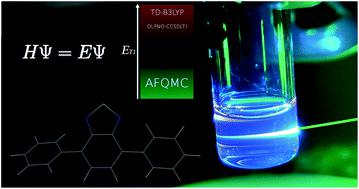当前位置:
X-MOL 学术
›
Chem. Sci.
›
论文详情
Our official English website, www.x-mol.net, welcomes your
feedback! (Note: you will need to create a separate account there.)
In silico prediction of annihilators for triplet–triplet annihilation upconversion via auxiliary-field quantum Monte Carlo
Chemical Science ( IF 7.6 ) Pub Date : 2020-11-17 , DOI: 10.1039/d0sc03381b John L Weber 1 , Emily M Churchill 1 , Steffen Jockusch 1 , Evan J Arthur 2 , Andrew B Pun 1 , Shiwei Zhang 3, 4 , Richard A Friesner 1 , Luis M Campos 1 , David R Reichman 1 , James Shee 1
Chemical Science ( IF 7.6 ) Pub Date : 2020-11-17 , DOI: 10.1039/d0sc03381b John L Weber 1 , Emily M Churchill 1 , Steffen Jockusch 1 , Evan J Arthur 2 , Andrew B Pun 1 , Shiwei Zhang 3, 4 , Richard A Friesner 1 , Luis M Campos 1 , David R Reichman 1 , James Shee 1
Affiliation

|
The energy of the lowest-lying triplet state (T1) relative to the ground and first-excited singlet states (S0, S1) plays a critical role in optical multiexcitonic processes of organic chromophores. Focusing on triplet–triplet annihilation (TTA) upconversion, the S0 to T1 energy gap, known as the triplet energy, is difficult to measure experimentally for most molecules of interest. Ab initio predictions can provide a useful alternative, however low-scaling electronic structure methods such as the Kohn–Sham and time-dependent variants of Density Functional Theory (DFT) rely heavily on the fraction of exact exchange chosen for a given functional, and tend to be unreliable when strong electronic correlation is present. Here, we use auxiliary-field quantum Monte Carlo (AFQMC), a scalable electronic structure method capable of accurately describing even strongly correlated molecules, to predict the triplet energies for a series of candidate annihilators for TTA upconversion, including 9,10 substituted anthracenes and substituted benzothiadiazole (BTD) and benzoselenodiazole (BSeD) compounds. We compare our results to predictions from a number of commonly used DFT functionals, as well as DLPNO-CCSD(T0), a localized approximation to coupled cluster with singles, doubles, and perturbative triples. Together with S1 estimates from absorption/emission spectra, which are well-reproduced by TD-DFT calculations employing the range-corrected hybrid functional CAM-B3LYP, we provide predictions regarding the thermodynamic feasibility of upconversion by requiring (a) the measured T1 of the sensitizer exceeds that of the calculated T1 of the candidate annihilator, and (b) twice the T1 of the annihilator exceeds its S1 energetic value. We demonstrate a successful example of in silico discovery of a novel annihilator, phenyl-substituted BTD, and present experimental validation via low temperature phosphorescence and the presence of upconverted blue light emission when coupled to a platinum octaethylporphyrin (PtOEP) sensitizer. The BTD framework thus represents a new class of annihilators for TTA upconversion. Its chemical functionalization, guided by the computational tools utilized herein, provides a promising route towards high energy (violet to near-UV) emission.
中文翻译:

通过辅助场量子蒙特卡罗对三重态-三重态湮没上转换的湮没子进行计算机预测
相对于基态和第一激发单重态(S0、S1)的最低三重态(T1)的能量在有机发色团的光学多激子过程中起着至关重要的作用。重点关注三重态-三重态湮灭 (TTA) 上转换,S0 到 T1 能隙(称为三重态能量)对于大多数感兴趣的分子来说很难通过实验测量。从头算预测可以提供一种有用的替代方案,但是低尺度电子结构方法(例如 Kohn-Sham 和密度泛函理论 (DFT) 的时间相关变体)严重依赖于为给定泛函选择的精确交换分数,并且倾向于当存在强电子相关性时,该值不可靠。在这里,我们使用辅助场量子蒙特卡罗(AFQMC),这是一种可扩展的电子结构方法,能够准确描述强相关分子,来预测 TTA 上转换的一系列候选湮没子的三重态能量,包括 9,10 取代的蒽和取代的苯并噻二唑(BTD)和苯并硒二唑(BSeD)化合物。我们将我们的结果与许多常用的 DFT 泛函以及 DLPNO-CCSD(T 0 ) 的预测进行比较,DLPNO-CCSD(T 0 ) 是具有单数、双数和微扰三元组的耦合簇的局部近似。结合吸收/发射光谱的 S1 估计(通过使用范围校正混合功能 CAM-B3LYP 的 TD-DFT 计算可以很好地再现),我们通过要求 (a) 测量的 T1 来提供有关上转换热力学可行性的预测。敏化剂超过计算出的候选湮灭子T1,并且(b)湮灭子T1的两倍超过其S1能量值。 我们展示了在计算机中发现新型消灭剂苯基取代的 BTD 的成功示例,并通过低温磷光和与铂八乙基卟啉 (PtOEP) 敏化剂耦合时存在上转换蓝光发射进行了实验验证。因此,BTD 框架代表了一类新的 TTA 上转换消灭器。在本文使用的计算工具的指导下,其化学功能化为高能(紫光到近紫外)发射提供了一条有前途的途径。
更新日期:2020-11-25
中文翻译:

通过辅助场量子蒙特卡罗对三重态-三重态湮没上转换的湮没子进行计算机预测
相对于基态和第一激发单重态(S0、S1)的最低三重态(T1)的能量在有机发色团的光学多激子过程中起着至关重要的作用。重点关注三重态-三重态湮灭 (TTA) 上转换,S0 到 T1 能隙(称为三重态能量)对于大多数感兴趣的分子来说很难通过实验测量。从头算预测可以提供一种有用的替代方案,但是低尺度电子结构方法(例如 Kohn-Sham 和密度泛函理论 (DFT) 的时间相关变体)严重依赖于为给定泛函选择的精确交换分数,并且倾向于当存在强电子相关性时,该值不可靠。在这里,我们使用辅助场量子蒙特卡罗(AFQMC),这是一种可扩展的电子结构方法,能够准确描述强相关分子,来预测 TTA 上转换的一系列候选湮没子的三重态能量,包括 9,10 取代的蒽和取代的苯并噻二唑(BTD)和苯并硒二唑(BSeD)化合物。我们将我们的结果与许多常用的 DFT 泛函以及 DLPNO-CCSD(T 0 ) 的预测进行比较,DLPNO-CCSD(T 0 ) 是具有单数、双数和微扰三元组的耦合簇的局部近似。结合吸收/发射光谱的 S1 估计(通过使用范围校正混合功能 CAM-B3LYP 的 TD-DFT 计算可以很好地再现),我们通过要求 (a) 测量的 T1 来提供有关上转换热力学可行性的预测。敏化剂超过计算出的候选湮灭子T1,并且(b)湮灭子T1的两倍超过其S1能量值。 我们展示了在计算机中发现新型消灭剂苯基取代的 BTD 的成功示例,并通过低温磷光和与铂八乙基卟啉 (PtOEP) 敏化剂耦合时存在上转换蓝光发射进行了实验验证。因此,BTD 框架代表了一类新的 TTA 上转换消灭器。在本文使用的计算工具的指导下,其化学功能化为高能(紫光到近紫外)发射提供了一条有前途的途径。











































 京公网安备 11010802027423号
京公网安备 11010802027423号